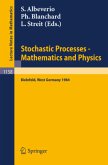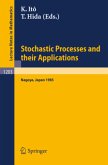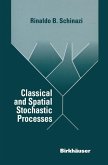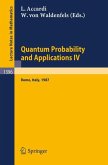Algebraic, differential, and integral equations are used in the applied sciences, en gineering, economics, and the social sciences to characterize the current state of a physical, economic, or social system and forecast its evolution in time. Generally, the coefficients of and/or the input to these equations are not precisely known be cause of insufficient information, limited understanding of some underlying phe nomena, and inherent randonmess. For example, the orientation of the atomic lattice in the grains of a polycrystal varies randomly from grain to grain, the spa tial distribution of a phase of a composite material is not known precisely for a particular specimen, bone properties needed to develop reliable artificial joints vary significantly with individual and age, forces acting on a plane from takeoff to landing depend in a complex manner on the environmental conditions and flight pattern, and stock prices and their evolution in time depend on a large number of factors that cannot be described by deterministic models. Problems that can be defined by algebraic, differential, and integral equations with random coefficients and/or input are referred to as stochastic problems. The main objective of this book is the solution of stochastic problems, that is, the determination of the probability law, moments, and/or other probabilistic properties of the state of a physical, economic, or social system. It is assumed that the operators and inputs defining a stochastic problem are specified.
"When familiar at least with the basics of measure theoretic probability, one may use this book to get a feel for the type of problems one tackles with the given methods and the type of results one can expect and then proceed to more detailed expositions.... The book is an impressive achievement." -Mathematical Reviews
"The large number of examples...as well as the good survey on advanced mathematical techniques make the textbook very valuable for people working in mathematics with a view towards applications.... The applications range from climate dynamics over material sciences and mechanics to pattern formation, physics and finance. The presentation is very successful in providing a sound mathematical background without getting lost in too much technical detail. Most results are proved completely, for the others the main ideas and intuition are given and references for detailed expositions are given.... At the end of each chapter a list of instructive exercises is provided. The long list of references covers theoretical mathematical works as well as highly applied areas. Altogether this textbook has all the necessary prerequisites for boosting the interdisciplinary collaboration between applied scientists and probabilists." -Zentralblatt Math
"This is an impressive compendium, which, on its first 280 pages, provides a quite thorough review of probability theory, stochastic processes, Itô's formula and stochastic differential equations.... Although the focus is on the mathematical theory, many examples from sciences or engineering illustrate the concepts and methods. Each chapter ends with a number of problems. This book will be of substantial interest to the applied scientists seeking methods to solve stochastic problems." -Monatshefte für Mathematik
"The large number of examples...as well as the good survey on advanced mathematical techniques make the textbook very valuable for people working in mathematics with a view towards applications.... The applications range from climate dynamics over material sciences and mechanics to pattern formation, physics and finance. The presentation is very successful in providing a sound mathematical background without getting lost in too much technical detail. Most results are proved completely, for the others the main ideas and intuition are given and references for detailed expositions are given.... At the end of each chapter a list of instructive exercises is provided. The long list of references covers theoretical mathematical works as well as highly applied areas. Altogether this textbook has all the necessary prerequisites for boosting the interdisciplinary collaboration between applied scientists and probabilists." -Zentralblatt Math
"This is an impressive compendium, which, on its first 280 pages, provides a quite thorough review of probability theory, stochastic processes, Itô's formula and stochastic differential equations.... Although the focus is on the mathematical theory, many examples from sciences or engineering illustrate the concepts and methods. Each chapter ends with a number of problems. This book will be of substantial interest to the applied scientists seeking methods to solve stochastic problems." -Monatshefte für Mathematik








